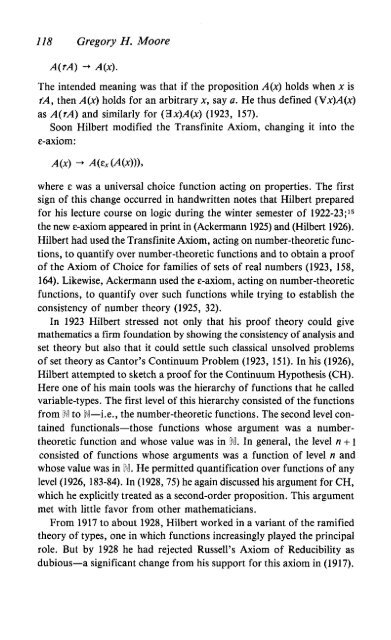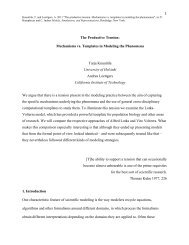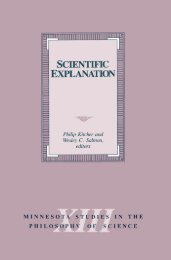The Emergence of First-Order Logic
The Emergence of First-Order Logic
The Emergence of First-Order Logic
You also want an ePaper? Increase the reach of your titles
YUMPU automatically turns print PDFs into web optimized ePapers that Google loves.
118 Gregory H. Moore<br />
<strong>The</strong> intended meaning was that if the proposition A (x) holds when x is<br />
r'A, then A (x) holds for an arbitrary x, say a. He thus defined (Vx)A(x)<br />
as A(rA) and similarly for (3*M(x) (1923, 157).<br />
Soon Hilbert modified the Transfinite Axiom, changing it into the<br />
e-axiom:<br />
where e was a universal choice function acting on properties. <strong>The</strong> first<br />
sign <strong>of</strong> this change occurred in handwritten notes that Hilbert prepared<br />
for his lecture course on logic during the winter semester <strong>of</strong> 1922-23 ; 15<br />
the new e-axiom appeared in print in (Ackermann 1925) and (Hilbert 1926).<br />
Hilbert had used the Transfinite Axiom, acting on number-theoretic functions,<br />
to quantify over number-theoretic functions and to obtain a pro<strong>of</strong><br />
<strong>of</strong> the Axiom <strong>of</strong> Choice for families <strong>of</strong> sets <strong>of</strong> real numbers (1923, 158,<br />
164). Likewise, Ackermann used the e-axiom, acting on number-theoretic<br />
functions, to quantify over such functions while trying to establish the<br />
consistency <strong>of</strong> number theory (1925, 32).<br />
In 1923 Hilbert stressed not only that his pro<strong>of</strong> theory could give<br />
mathematics a firm foundation by showing the consistency <strong>of</strong> analysis and<br />
set theory but also that it could settle such classical unsolved problems<br />
<strong>of</strong> set theory as Cantor's Continuum Problem (1923, 151). In his (1926),<br />
Hilbert attempted to sketch a pro<strong>of</strong> for the Continuum Hypothesis (CH).<br />
Here one <strong>of</strong> his main tools was the hierarchy <strong>of</strong> functions that he called<br />
variable-types. <strong>The</strong> first level <strong>of</strong> this hierarchy consisted <strong>of</strong> the functions<br />
from n to M—i.e., the number-theoretic functions. <strong>The</strong> second level contained<br />
functionals—those functions whose argument was a numbertheoretic<br />
function and whose value was in 1M. In general, the level « +1<br />
consisted <strong>of</strong> functions whose arguments was a function <strong>of</strong> level « and<br />
whose value was in M. He permitted quantification over functions <strong>of</strong> any<br />
level (1926, 183-84). In (1928, 75) he again discussed his argument for CH,<br />
which he explicitly treated as a second-order proposition. This argument<br />
met with little favor from other mathematicians.<br />
From 1917 to about 1928, Hilbert worked in a variant <strong>of</strong> the ramified<br />
theory <strong>of</strong> types, one in which functions increasingly played the principal<br />
role. But by 1928 he had rejected Russell's Axiom <strong>of</strong> Reducibility as<br />
dubious—a significant change from his support for this axiom in (1917).




